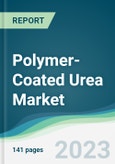The polymer-coated urea market is expected to grow at a CAGR of 6.41% during the forecast period
When urea is polymer-coated, it is released by diffusion. The polymer covering allows water to get through, dissolving it and the urea within. Urea slowly seeps through the covering and into the soil, where it transforms into nitrogen (N) that plants may utilise.Polymer sulfur-coated urea is crucial for attaining cost- and market-effectiveness improvements, soil fertility preservation, high agricultural yields, and addressing climate change. Grain and cereal production, pulse and oilseed production, commercial crops, fruits, vegetables, turf and decorative crops.
Market Drivers:
Minimizing cost and maximizing benefits with ESN polymer-coated urea
The majority of maize side-dress N applications are made in June when temperatures are higher, where utilising 100% ESN polymer-coated urea may not be the ideal choice as the objective is to have at least some N readily accessible. On the other hand, pre-plant applications of ESN polymer-coated urea can be helpful to protect N in parts of the field where N loss is more likely to happen.In exceptionally rainy springs or soils with a high propensity for N loss, there is frequently a big return from using ESN polymer-coated urea. This is predicted to be influential in the polymer-coated urea market size.
The growing prominence of speciality fertilizers
Sometimes manufacturers would coat an existing product to add value and create something that could be offered as a high-end speciality product.Therefore, rather than spending money on a completely new process and equipment, businesses may incorporate a coating line into their current manufacturing facility or, where one is available, use an existing coating line. These factors are anticipated to be the key driving factors for polymer-coated urea fertilizers.
Increase in usage of polymer-coated urea in the agriculture sector
The market is expanding as a result of growing concerns in the agricultural industry, such as a strict regulatory framework on conventional fertilizers and eutrophication. The inclination of consumers for upscale amenities like a home lawn is growing, which is accelerating market development.In addition to this, it is anticipated that the growing number of golf courses in the world will spur polymer-coated urea market size in the projected period. Furthermore, it is anticipated that the most recent possibilities will be created in the worldwide industry, with multinational and regional market participants using these prospects with affordable products to participate in the profits and upsurge the growth for the polymer-coated urea market.
Opportunities in the polymer sulphur-coated urea
Polymer sulphur-coated urea blends well and is reasonably priced as compared to traditional urea. As a result, it may be utilized as a good substitute for managing nitrogen in high-grain yield crops like rice, maize, etc. Additionally, the increased use of polymer sulphur-coated urea in agricultural applications, notably for grain crops, and technical developments in the agriculture sector drive the polymer-coated urea market expansion.North America is emerging as a market leader
North America is anticipated to dominate the polymer-coated urea market. There is high demand for cotton in the North American region and since cotton is one of the most important commercial crops and fertilization is essential to enhancing the quality of fiber, Polymer-coated urea is finding major usage in fertilizers improve nutrient-use efficiency in cotton in line with 4R nutrient stewardship, which comprises the appropriate fertilizer source, at the right time, right place, and at the right rate.Europe to show significant growth
In the Western European region, there is a lack of farm labour and labour expenses are high. As a result, biodegradable polymer-coated urea fertilizers are being used instead of traditional fertilizers since they demand less labour and have shorter application intervals.Fertilizers with regulated or gradual releases ensures that nitrogen is available throughout the whole crop cycle. Additionally, it was discovered that the wheat lots in the EU region were unsuitable for milling due to poor grain protein concentration. By using biodegradable polymer-coated urea fertilizers, this problem can be solved.
Company Products
- Polyon®, The fertiliser coating technique Polyon®, Polymer Coated Urea (PCU), regulates the release of nitrogen to suit the extended feeding requirements of turfgrass and ornamentals.
- SMARTGRO® 43-0-0+TE, A polymer-coated urea (PCU) provided by Smart Fert Sdn Bhd is a nitrogen source that is both safer and more effective. In essence, this nitrogen fertiliser has a clever release system that nourishes your plants all season long.
- CoteN, CoteN is a kind of Controlled Release Fertiliser (CRF) from the Multicote line created by Haifa Group. CoteNTM is a precise and reliable N supply for the crops thanks to its correct fertiliser release over time, which is solely controlled by soil temperature.
Market Key Developments
- In September 2022, The On-Farm Climate Action Fund (OFCAF) of the federal government included polymer-coated urea on its list of increased-efficiency fertilizer products that are eligible for reimbursement.
- In September 2021, Harrell's LLC entered into a collaboration with marion AG Service for the formulation, mixing, packaging, and distribution of the controlled-release POLYON® brand and in the Pacific Northwest. fertilizer.
Segmentation:
By Crop Type
- Grains and Cereals
- Pulses and Oilseeds
- Commercial Crops
- Fruits and Vegetables
- Turf and Ornamentals
By Type
- Biodegradable
- Non-biodegradable
By Application
- Agriculture
- Golf Courses
- Lawn and Turf
- Others
By Geography
- North America
- United States
- Canada
- Mexico
- South America
- Brazil
- Argentina
- Others
- Europe
- United Kingdom
- Germany
- France
- Spain
- Others
- Middle East and Africa
- Saudi Arabia
- UAE
- Israel
- Others
- Asia Pacific
- Japan
- China
- India
- South Korea
- Indonesia
- Thailand
- Others
Table of Contents
Companies Mentioned
- Bayer CropScience AG
- Novozymes A/S
- BASF SE
- Syngenta AG
- Koppert Biological systems
- Marrone Bio Innovations, Inc.
- Biobest N.V.
- Andermatt Biocontrol AG
- Certis USA LLC
- Haifa Group








